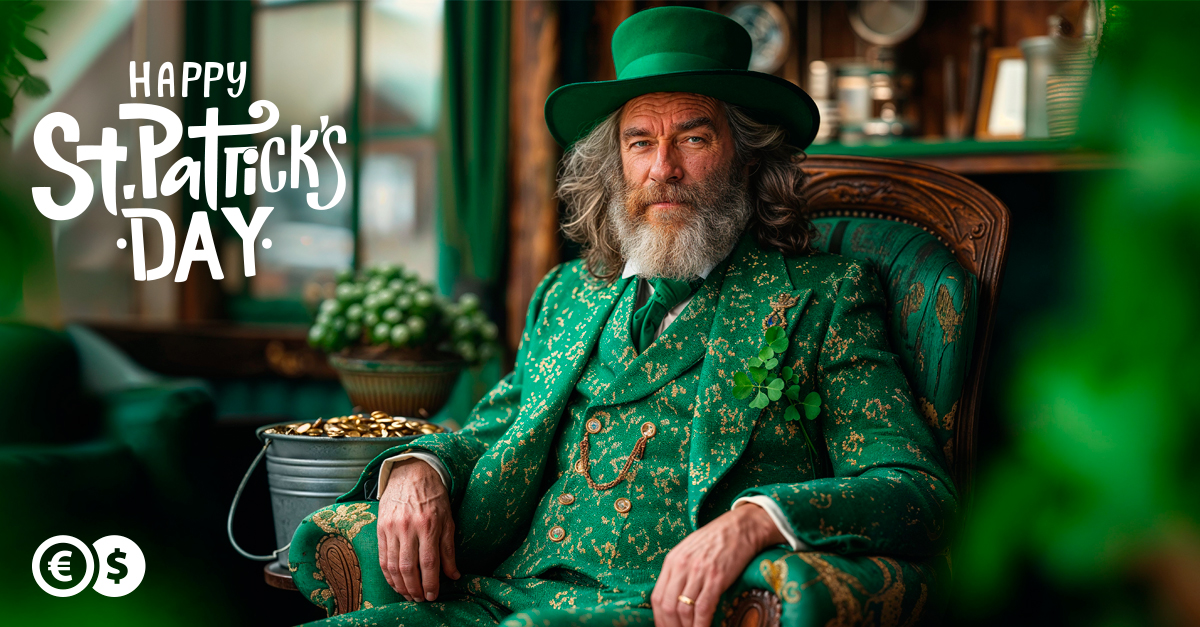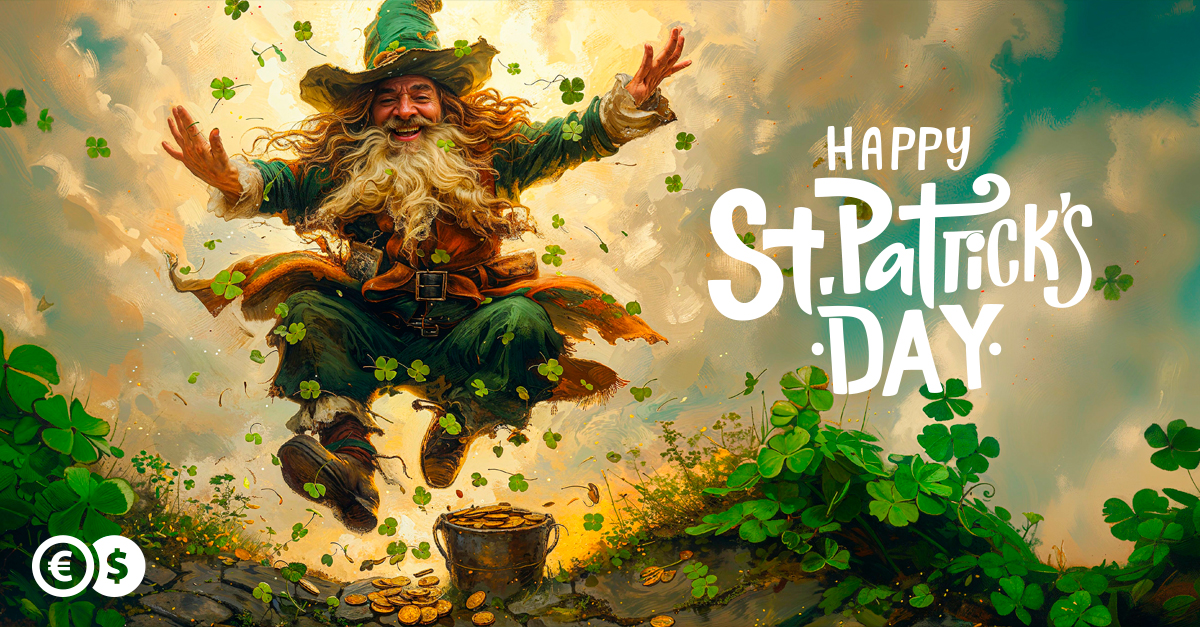On 17 March, Irish people worldwide celebrate St Patrick's Day lavishly and joyfully. The international holiday can be an excuse to plan a trip to Dublin. There are plenty of attractions, and the time seems right. Conotoxia currency experts suggest how much it will cost to fly to Ireland, find accommodation and what the prices are on the spot.
Table of contents

The Irish celebrate 17 March in honour of the bishop, missionary and patron saint of the country who lived and evangelised in the fifth century. It is believed that St Patrick died on 17 March 461, which is why the date has become a national holiday in Ireland. Schools and workplaces are closed, and people participate in processions, historical re-enactments, concerts and dance performances. After the street parades, the party continues in the pubs. A similar celebration takes place in many countries on 17 March (partly due to the large Irish emigration), with customers turning to the exceptional beer associated with Ireland.
What's worth seeing in Dublin?
Millions of pints of Guinness beer are drunk worldwide every day, nearly two billion a year. It is one of Ireland's most famous exports. This is one of the reasons why you can start your visit to Dublin with the Guinness Brewery in the city centre, the most visited tourist attraction in the Irish capital.
"Guinness beer, named after the brewery's founder Arthur Guinness, has been produced in Dublin since 1759, and today's brewery is divided into two parts: the production area and the museum, designed to resemble a giant beer mug. Over several floors, visitors can learn about the secrets and stages of making the drink, which is made from barley, water, hops, yeast and water, with the dark colour coming from an additive - roasted barley malt. The ticket price for visitors - which starts at 26 euros (about 22 GBP at Conotoxia's exchange rates) - also includes a tasting, which takes place on the top floor of the building with a magnificent view of Dublin," note Conotoxia's currency experts.
The museum and gift shop are open seven days a week from 10 am to 5 pm on weekdays, 9.30 am to 6 pm on Saturdays and 9.30 am to 5 pm on Sundays, attracting more than 1.5 million visitors yearly (2023 data).
Dublin and Ireland are also famous for producing and exporting whiskey, and the Old Jameson Distillery, now a museum, reveals the secrets of production and offers samples for adult visitors to taste.
Sticking to the museum route, it is also worth visiting Kilmainham Gaol, once a huge prison. It's chilly in the cells and corridors of the grey stone block, so before entering Kilmainham - a normal ticket costs 8 euros (about 7 GBP) - dress warmly and allow about two hours to explore the whole place. The tour includes the original cells, the courtyard, the prison chapel, an audio-visual show and poignant stories told by the tour guide about the people held at Kilmainham.
The museum is open every day from January to June from 9.30 am to 5.15 pm, July and August from 9.30 am to 5.45 pm and September to December from 9.30 am to 5 pm.

Monuments, live music and Irish specialities
To get around Dublin more affordably without having to use taxis or a hire car, you can order a TFI Leap Card (leapcard.ie) online, which entitles you to discounts on all TFI public transport (including Dublin Bus, Go-Ahead Ireland, Luas, DART and suburban rail).
It is impossible to see all the major attractions on foot. The Royal Castle, the National Gallery, Ireland's oldest university, the 120-metre Spire, St Patrick's Cathedral and Christ Church, the many symbols of the 1916 Easter Rising - these are just a few of Dublin's highlights, and the city is full of artists' studios, theatres and art exhibitions. The atmosphere in the Irish capital is conducive to artists; after all, it was in Dublin that they worked: Oscar Wilde, James Joyce and Samuel Beckett, among others. Famous musicians and bands have also come from here, including Bob Geldof, Sinead O'Connor, U2 and Thin Lizzy.
Live music reverberates in pubs daily. The Irish don't need much persuasion to make music and sing along, and pubs in Dublin are plentiful. With a few days' stay, it isn't easy to visit even half of them in just the Temple Bar district, known for its many cultural institutions and nightlife.
As well as exported Irish drinks and Irish-style coffee, you can also enjoy the specialities of the local cuisine, which is based on traditional and comforting dishes. Almost every restaurant serves mutton dishes, stews and dark pastries.

What are the prices in Ireland? And how do you pay in Ireland?
"A return ticket from London, for example, costs around 240 GBP. Accustomed to the crowds, the people of Dublin and its environs have prepared a vast accommodation base for visitors: hotels, hostels, guesthouses, apartments, suites and lodgings, in which there should be no shortage of places. Prices? A weekend stay (two nights) for two people usually costs around 300 GBP, but it is possible to find offers for half as much or twice as much," calculate Conotoxia specialists.
In Irish shops, venues, museums, etc., prices are usually similar than in the UK, e.g. for a 1.5-litre bottle of water in a market, you will pay more than 2 EUR, for a meal for two in a restaurant about 80 EUR (about 70 GBP), for a set in a fast food joint 8-10 EUR, and a beer in a pub 6 EUR.
The exchange rate of the currency in Ireland has dropped against the British pound in recent months. A depreciation of the euro may encourage people to travel to the green island, even if it is no longer possible to do so on St Patrick's Day. Is it worth exchanging the GBP for the euro before a trip to Ireland? "It is certainly worth having some cash with you, but the most convenient way to pay locally is with a multi-currency card, which allows payments abroad and cash withdrawals from ATMs abroad. Such cards can be topped up with funds on an ongoing basis, keeping expenses in check and protecting money from possible theft or loss," - point out experts of the fintech Conotoxia.



